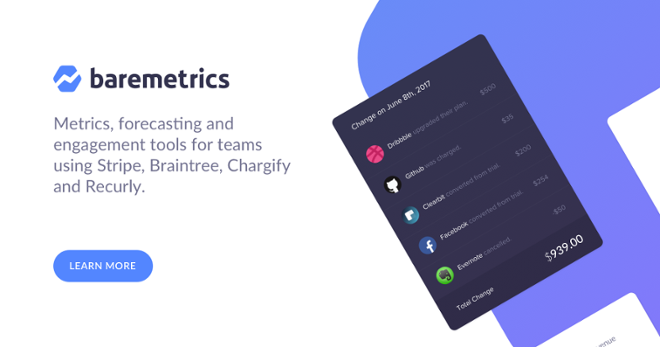Churn is a really big deal in SaaS... but which is a "bigger" deal? Customer churn, or revenue churn?
Today, I'm looking at the differences between these two essential SaaS metrics, and helping you to use them to monitor and improve the growth of your own SaaS startup.
Customer Churn
Customer churn (also known as "Logo Churn") measures the rate at which your customers cancel their subscription to your service.
Almost all SaaS companies are subscription-based business. As a result, your growth depends on both maximising new customers, and minimising the churn of existing customers.
{{cta('28e8f9f8-27b1-4939-b6a7-aeae31bd25f5')}}
The customer churn formula below allows you to monitor the rate at which you're losing customers each month:
$$\text{% Customer churn rate}=\frac{\text{Customers that churned in period t}}{\text{Total customers at the start of period t}}$$
For example, if we ended January with 20 paying customers, and a month later, we'd lost 2 of those customers to churn, we'd have a customer churn rate of 10%. In other words, during the month of February, we lost 10% of our customer base to churn:
$$\text{January: 20 customers}$$
$$\text{February: 18 customers}$$
$$\text{% Customer churn rate}=\frac{(20-18)}{20}=\frac{2}{20}=10\%$$
Revenue Churn
Revenue churn (also known as "MRR churn rate") is used to look at the rate at which monthly recurring revenue (MRR) is lost, as a result of churned customers and downgraded subscriptions.
The formula for revenue churn is similar to customer churn:
$$\text{% MRR churn rate}=\frac{\text{Churned MRR}}{\text{Previous month's MRR}}$$
If we go back to our earlier example, and add in MRR figures, we end up with a revenue churn rate of 10%. In other words, as a result of those 2 churned customers, February saw a loss of 10% of our monthly recurring revenue:
$$\text{January: 20 customers}\times$200=$4,000\text{MRR}$$
$$\text{February: 18 customers}\times$200=$3,600\text{MRR}$$
$$\text{Revenue churn}=\frac{(4,000-3,600)}{4,000}=\frac{400}{4,000}=10\%$$
For a few alternative ways to calculate both customer churn and revenue churn, check out the Essential SaaS Metrics Glossary.
Customer Churn vs Revenue Churn
When it comes to churn metrics, it might be tempting to dial-in on the one "ultimate" metric and disregard all others. In this instance though, we need to keep a close eye on both customer churn and revenue churn.
-
Customer churn tells you how good you are at retaining customers.
-
Revenue churn tells you how good you are at retaining customer revenue.
These two concepts are similar, but they aren't the same.
The examples we calculated above were incredibly simple: 10% customer churn resulted in 10% revenue churn. In reality though, things like different pricing packages, and additional seats, users and storage, can make churn calculations much more complicated.
And as we're about to see, customer churn doesn't always do a great job at predicting revenue churn (and vice versa).
Negative Revenue Churn
Time for another example: imagine we have 3 customers, each paying $200 per month. In January, our MRR looks like this:
$$\text{January:}$200+$200+$200=$600\text{MRR}$$
When it comes time to renew in February, we lose a customer to churn...
$$\text{February:}$200+$200+$0=$400\text{MRR}$$
...but successfully upsell the remaining two customers, switching them to a higher-priced package for an additional $150 MRR per customer.
$$\text{February:}$350+$350+$0=$700\text{MRR}$$
Here's what customer churn and revenue churn look like over that period:
$$\text{Customer churn}=\frac{(3-2)}{3}=\frac{1}{3}\approx33\%$$
$$\text{Revenue churn}=\frac{(600-700)}{600}=\frac{-100}{600}\approx-17\%$$
In isolation, these metrics would tell very conflicting stories.
A churn rate of 33% is hugely problematic in SaaS, and you'd be inclined to assume that your MRR had fallen alongside.
On the other hand, we have negative revenue churn over the same time period: thanks to the power of upselling, we've actually increased our MRR, despite losing a customer.
Two Crucial SaaS Metrics
Both of these metrics look at different aspects of your company's health, and in terms of deciding which is "best", or which takes precedence, the simple answer is neither.
To get a balanced view of your growth, you need to analyse both of these metrics on a regular basis, for two simple reasons:
-
Retention matters. If left unchecked, even low customer churn can become a serious problem, so it's vital to monitor and improve customer churn over time.
-
Upselling matters. If you're able to upsell your customers onto higher-value packages, and sell additional recurring seats/users/storage, you can combat the effects of customer churn. Revenue churn will help you understand how efficient you are at retaining (and growing) your MRR.





